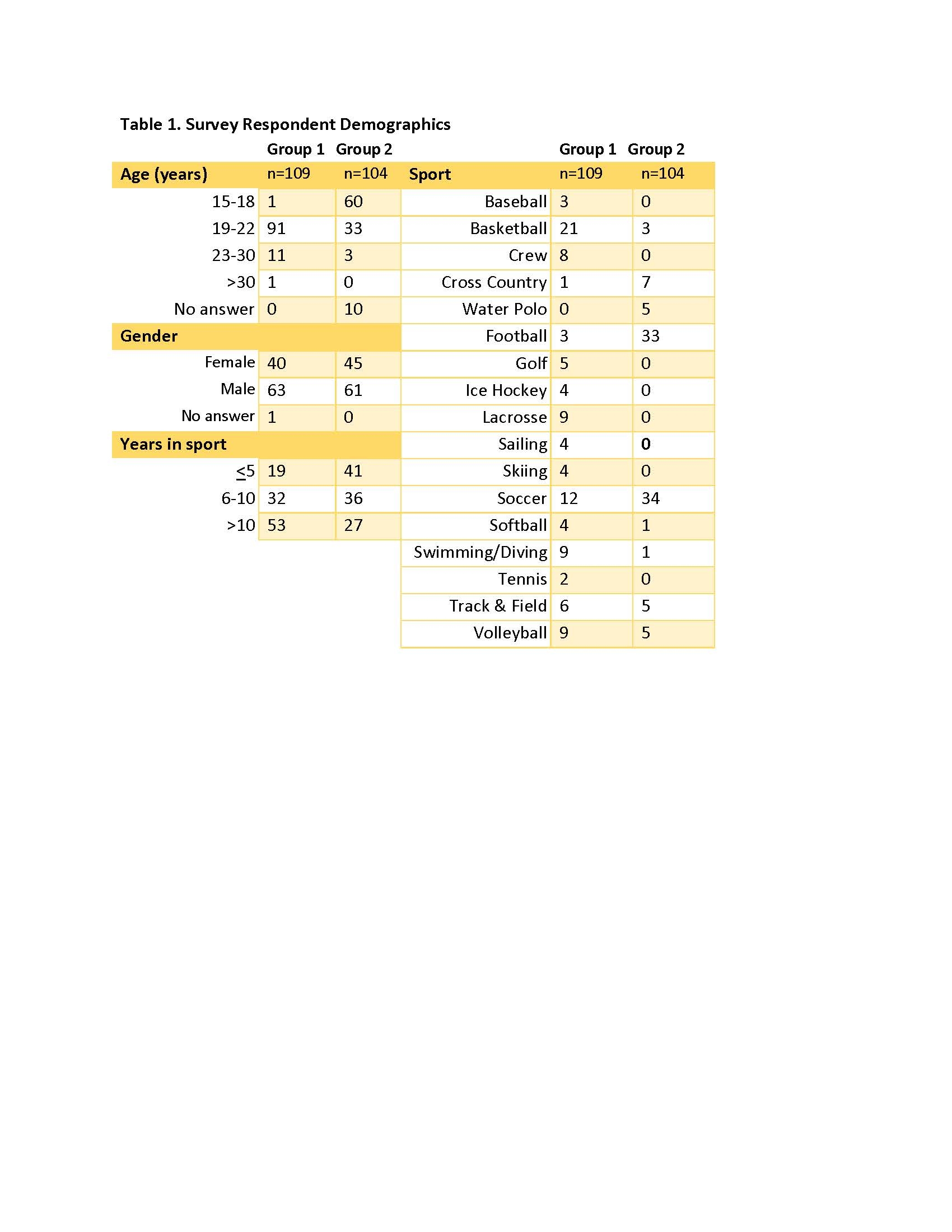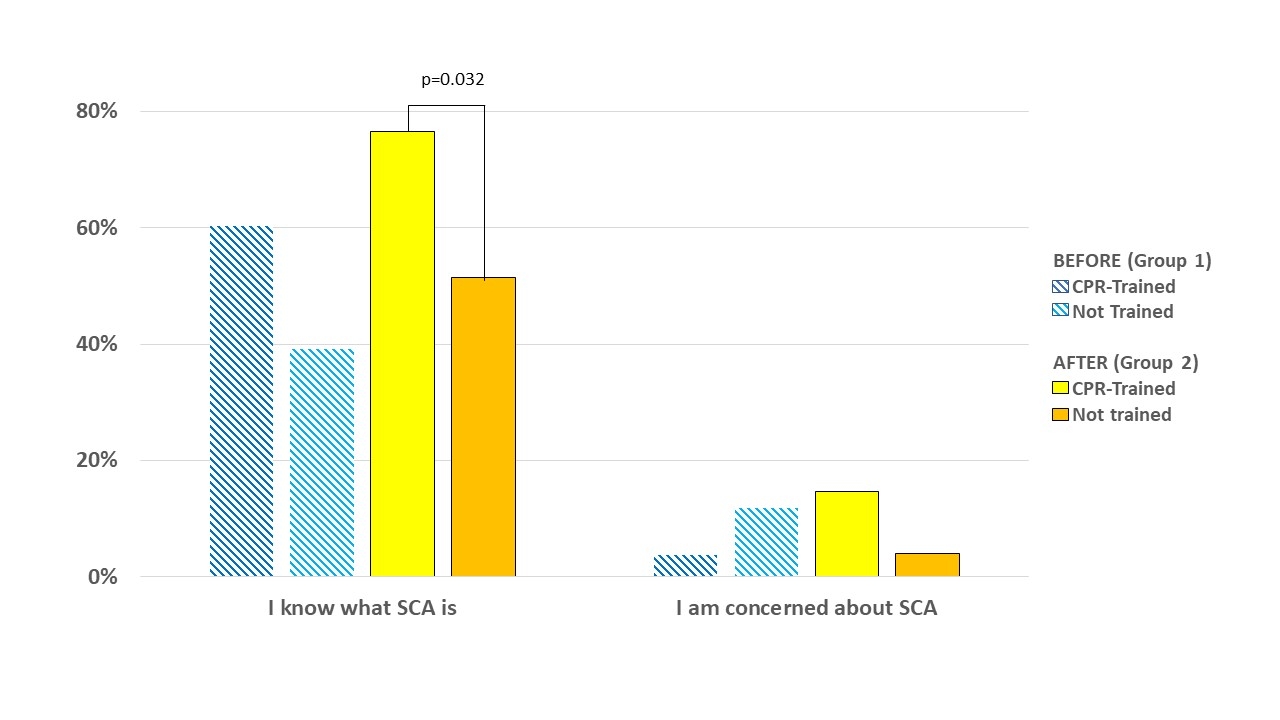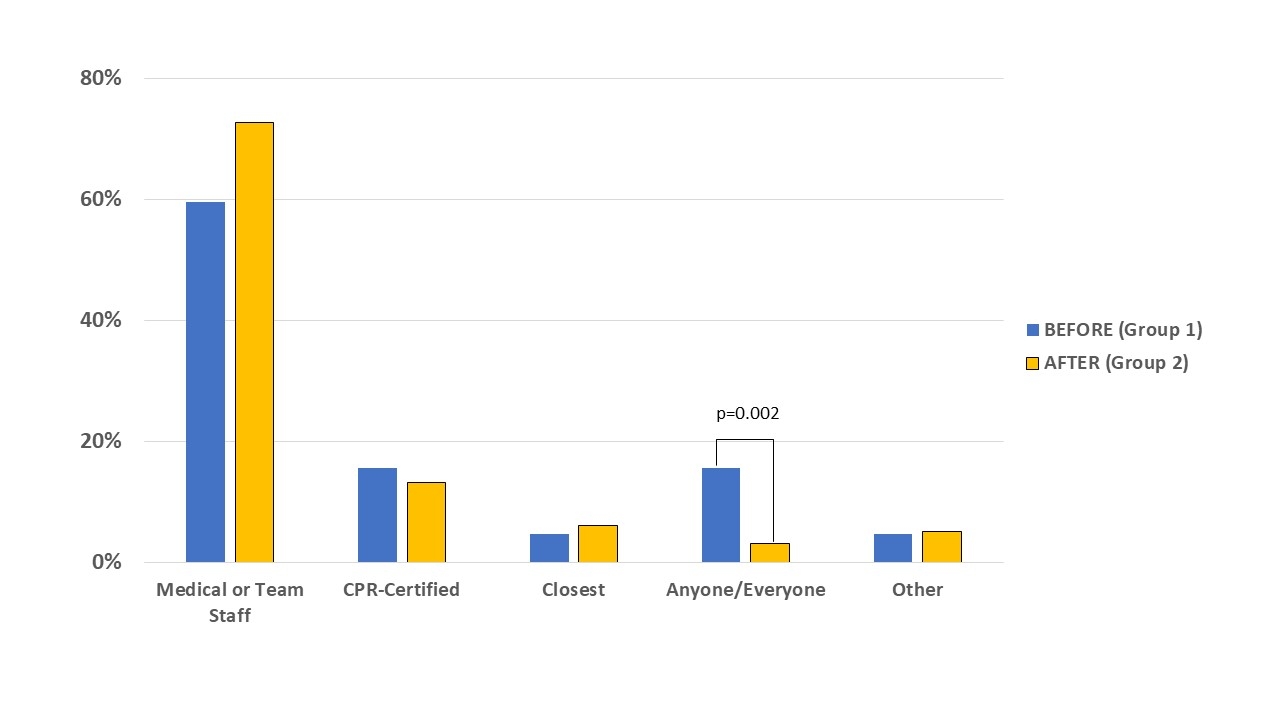Final ID: Su1401
Sports-related sudden cardiac arrest: Competitive athlete awareness before vs. after high-profile events
Abstract Body: BACKGROUND
Sports-related sudden cardiac arrest (SR-SCA) has captivated American attention following recent high-profile competitive athlete events.1 SR-SCA accounts for approximately 39% of SCA among <18 year-olds, and 13% of 19-25 year-olds in the U.S. Although the number of deaths due to SR-SCA is low, the loss of young life is devastating to families, friends, and communities.
HYPOTHESIS
We hypothesized that high-profile SR-SCA events would increase competitive athletes’ awareness of, concern about their personal risk, and sense of responsibility to respond to SCA.
METHODS
We performed a survey of competitive collegiate athletes. Group 1 (n=109) completed the survey in 2022 PRIOR to high-profile events. Group 2 (n=104) completed the survey in 2024. This study was approved by the University of Nevada, Reno IRB (2020866).
RESULTS
Table 1 details demographic information for our representative sample of athletes. Overall, there was no difference in answering “do you know what SCA is?” before v. after high-profile events (50.0% v 60.4%, p=0.1605). There was no increase in concern about personal SCA (7.7% v 7.8%, p=1.00), with very low percentage of athletes demonstrating concern. In both groups, more CPR-trained athletes compared to untrained reported knowing what SCA is (group 1 60.3% v 39.2%, p=0.079; group 2 76.5% v 51.4%, p=0.032). In group 1, CPR-trained athletes were less concerned than untrained about SCA (3.8% v 11.8%, p=0.255); this was reversed in group 2 with more CPR-trained athletes concerned about SCA (15.7% v 4.0%, p=0.074) (Fig 1). When asked “whose responsibility is it to resuscitate a fallen athlete,” the majority identified medical/team staff (59.6% v 72.7%, p=0.057), although significantly more athletes in group 1 identified anyone/everyone as potential rescuers (15.6% v 3.1%, p=0.002). A minority in both groups (4.6%, 6.1%) said whoever is closest (Fig 2).
CONCLUSION
Recent high-profile SR-SCA events have captured national attention and led to policy change, law passage, and significant funding efforts. However, the knowledge and perspectives of competitive collegiate athletes towards SR-SCA has not changed.
Sports-related sudden cardiac arrest (SR-SCA) has captivated American attention following recent high-profile competitive athlete events.1 SR-SCA accounts for approximately 39% of SCA among <18 year-olds, and 13% of 19-25 year-olds in the U.S. Although the number of deaths due to SR-SCA is low, the loss of young life is devastating to families, friends, and communities.
HYPOTHESIS
We hypothesized that high-profile SR-SCA events would increase competitive athletes’ awareness of, concern about their personal risk, and sense of responsibility to respond to SCA.
METHODS
We performed a survey of competitive collegiate athletes. Group 1 (n=109) completed the survey in 2022 PRIOR to high-profile events. Group 2 (n=104) completed the survey in 2024. This study was approved by the University of Nevada, Reno IRB (2020866).
RESULTS
Table 1 details demographic information for our representative sample of athletes. Overall, there was no difference in answering “do you know what SCA is?” before v. after high-profile events (50.0% v 60.4%, p=0.1605). There was no increase in concern about personal SCA (7.7% v 7.8%, p=1.00), with very low percentage of athletes demonstrating concern. In both groups, more CPR-trained athletes compared to untrained reported knowing what SCA is (group 1 60.3% v 39.2%, p=0.079; group 2 76.5% v 51.4%, p=0.032). In group 1, CPR-trained athletes were less concerned than untrained about SCA (3.8% v 11.8%, p=0.255); this was reversed in group 2 with more CPR-trained athletes concerned about SCA (15.7% v 4.0%, p=0.074) (Fig 1). When asked “whose responsibility is it to resuscitate a fallen athlete,” the majority identified medical/team staff (59.6% v 72.7%, p=0.057), although significantly more athletes in group 1 identified anyone/everyone as potential rescuers (15.6% v 3.1%, p=0.002). A minority in both groups (4.6%, 6.1%) said whoever is closest (Fig 2).
CONCLUSION
Recent high-profile SR-SCA events have captured national attention and led to policy change, law passage, and significant funding efforts. However, the knowledge and perspectives of competitive collegiate athletes towards SR-SCA has not changed.
More abstracts on this topic:
A Multicentre Study for Hands Only CPR (HOCPR) training assessment towards building a ‘Nation of Life Savers” in India
Ravikumar Thanjavur, Sarma Kvs, Ravikumar Thanjavur, Sarkar Manuj, Debnath Dhrubajyoti, Behera Priyamadhaba, Ghate Jayshri, Trikha Divay, Samantaray A, Madhavi K
Exploring the Role of Podcasts in Stroke Recovery and PreventionHart Rosa



